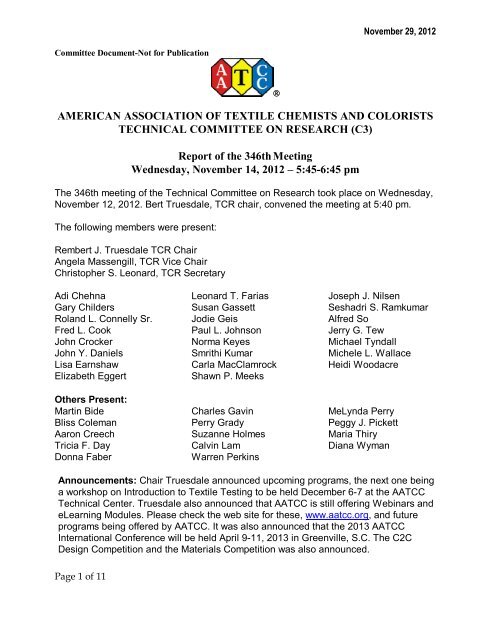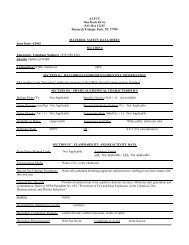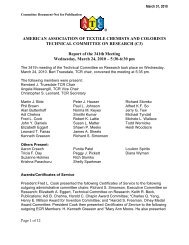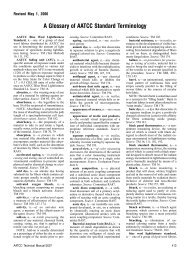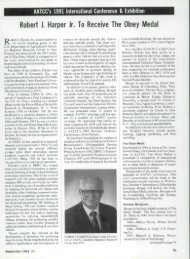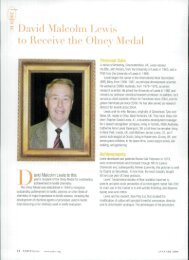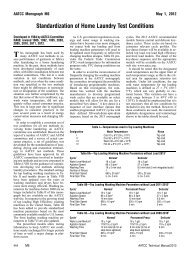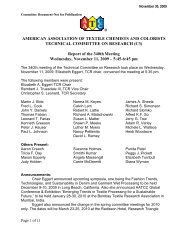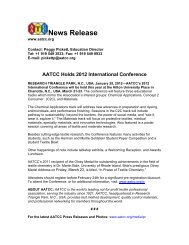November 2012 - AATCC. American Association of Textile Chemists ...
November 2012 - AATCC. American Association of Textile Chemists ...
November 2012 - AATCC. American Association of Textile Chemists ...
Create successful ePaper yourself
Turn your PDF publications into a flip-book with our unique Google optimized e-Paper software.
Committee DocumentNot for Publication<br />
Page 1 <strong>of</strong> 11<br />
®<br />
<strong>November</strong> 29, <strong>2012</strong><br />
AMERICAN ASSOCIATION OF TEXTILE CHEMISTS AND COLORISTS<br />
TECHNICAL COMMITTEE ON RESEARCH (C3)<br />
Report <strong>of</strong> the 346th Meeting<br />
Wednesday, <strong>November</strong> 14, <strong>2012</strong> – 5:456:45 pm<br />
The 346th meeting <strong>of</strong> the Technical Committee on Research took place on Wednesday,<br />
<strong>November</strong> 12, <strong>2012</strong>. Bert Truesdale, TCR chair, convened the meeting at 5:40 pm.<br />
The following members were present:<br />
Rembert J. Truesdale TCR Chair<br />
Angela Massengill, TCR Vice Chair<br />
Christopher S. Leonard, TCR Secretary<br />
Adi Chehna<br />
Gary Childers<br />
Roland L. Connelly Sr.<br />
Fred L. Cook<br />
John Crocker<br />
John Y. Daniels<br />
Lisa Earnshaw<br />
Elizabeth Eggert<br />
Others Present:<br />
Martin Bide<br />
Bliss Coleman<br />
Aaron Creech<br />
Tricia F. Day<br />
Donna Faber<br />
Leonard T. Farias<br />
Susan Gassett<br />
Jodie Geis<br />
Paul L. Johnson<br />
Norma Keyes<br />
Smrithi Kumar<br />
Carla MacClamrock<br />
Shawn P. Meeks<br />
Charles Gavin<br />
Perry Grady<br />
Suzanne Holmes<br />
Calvin Lam<br />
Warren Perkins<br />
Joseph J. Nilsen<br />
Seshadri S. Ramkumar<br />
Alfred So<br />
Jerry G. Tew<br />
Michael Tyndall<br />
Michele L. Wallace<br />
Heidi Woodacre<br />
MeLynda Perry<br />
Peggy J. Pickett<br />
Maria Thiry<br />
Diana Wyman<br />
Announcements: Chair Truesdale announced upcoming programs, the next one being<br />
a workshop on Introduction to <strong>Textile</strong> Testing to be held December 67 at the <strong>AATCC</strong><br />
Technical Center. Truesdale also announced that <strong>AATCC</strong> is still <strong>of</strong>fering Webinars and<br />
eLearning Modules. Please check the web site for these, www.aatcc.org, and future<br />
programs being <strong>of</strong>fered by <strong>AATCC</strong>. It was also announced that the 2013 <strong>AATCC</strong><br />
International Conference will be held April 911, 2013 in Greenville, S.C. The C2C<br />
Design Competition and the Materials Competition was also announced.
Nominations are now being sought for the 2014 TCR Service Award. The<br />
deadline for the 2014 TCR Service Award is October 1, 2013. If you know <strong>of</strong> a<br />
deserving senior individual member <strong>of</strong> <strong>AATCC</strong>, please submit the nomination by<br />
October 1, 2013. You may access the criterion for this Award by clicking on<br />
http://www.aatcc.org/general/awards/TCR.htm. You may also access the nomination<br />
form at the same link.<br />
RA23, Colorfastness to Water: The proposed revisions <strong>of</strong> <strong>AATCC</strong> Methods 15<br />
(Colorfastness to Perspiration) and 107 (Colorfastness to Water) to add a note <strong>of</strong><br />
caution in each method regarding results obtained for staining was approved and will<br />
now be submitted to a TCR Letter Ballot. A revision to TM 15 is being considered to<br />
specify that a glass Petri dish be used in the procedure and to also list this item in the<br />
Materials Section. The committee is still waiting on the statistical analysis <strong>of</strong> the two<br />
oven types’ impact on TM 107. It should be completed and distributed prior to the<br />
spring 2013 meeting. There was also a discussion <strong>of</strong> the acrylic plates used in TMs 15<br />
and 107. There are no dimensions specified in the methods (width, length and<br />
thickness). Lisa Earnshaw <strong>of</strong> James Heal and John Crocker <strong>of</strong> SDL Atlas will take<br />
inventory <strong>of</strong> what they currently supply and report back to the committee. Concerns<br />
were brought up also about the fact that the weight is specified but no pressure. It was<br />
decided that it is best to keep the weight and the dimensions the same, as for auditors<br />
and labs, as it would be difficult to specify the pressure. There was a question<br />
regarding the expiration period <strong>of</strong> sea water solutions. Earnshaw has volunteered to<br />
conduct a study by making a solution and testing it as the solution sits to see if there is<br />
any impact on the results. There were still no volunteers for a new chair. Ellen Roaldi <strong>of</strong><br />
Bureau Veritas was nominated to continue to act as chair for 2013. This subject will be<br />
brought up again in May 2013.<br />
RA24, Fiber Analysis: The <strong>2012</strong> second round PT was reviewed for the PET/PTT and<br />
Rayon/Cotton blends distributed. Mechanical separation variation was found to be<br />
about ± 1%. Chemical separation variation was found to be about ± 4%. The 2013 first<br />
round PT was determined to be Alpaca/Wool and Acetate/Spandex. Information to<br />
support the addition <strong>of</strong> PBI will be sent to committee letter ballot so that this generic<br />
class can be added to TM20 (Fiber Analysis: Qualitative) and TM20A (Fiber Analysis:<br />
Quantitative) . Robina Hogan <strong>of</strong> Omni Tech International gave a very well received<br />
PowerPoint on “Fibers Containing Soy Protein” and a Soy Fiber Subcommittee was<br />
created with six members. Suggestions for the improvement <strong>of</strong> TM20A, Table 1,<br />
provided by Seemanta Mitra <strong>of</strong> Intertek were reviewed and will be sent out to committee<br />
ballot. In Method 9 <strong>of</strong> TM20A, the boiling point <strong>of</strong> methanol will be corrected to 65°C.<br />
The Glass Fiber Subcommittee was renamed the Silica Fiber Subcommittee.<br />
Incorporation <strong>of</strong> silica fibers into TM20 and 20A is being investigated. Ionic solvents<br />
such as 13 Butyl3methylimidazolium chloride are being investigated for use in<br />
TM20A. A Correction Factor <strong>of</strong> 1.046 for rayon will be added to TM20A. A statement<br />
that "hair" fibers referenced in TM20A are synonymous with "specialty animal fibers or<br />
nonwool fibers with scales on their surface" in Table 1 <strong>of</strong> TM20 will be added.<br />
Page 2 <strong>of</strong> 11
RA31, Antimicrobial Activity: It was reported that the participating labs in the Anti<br />
bacterial Pr<strong>of</strong>iciency Testing Program is down from 25 labs to 17. The next round <strong>of</strong><br />
testing is scheduled for April and October 2013. If anyone needs additional information,<br />
contact Aaron Creech, <strong>AATCC</strong>, or go online at www.aatcc.org. The data from the<br />
pr<strong>of</strong>iciency testing, if suitable, will be used to prepare a precision and bias statement<br />
for TMs 100 (Antibacterial Finishes on <strong>Textile</strong> Materials: Assessment <strong>of</strong>) and 147<br />
(Antibacterial Activity Assessment <strong>of</strong> <strong>Textile</strong> Materials: Parallel Streak Method). A<br />
working copy <strong>of</strong> TM 30 (Antifungal Activity, Assessment on <strong>Textile</strong> Materials: Mildew<br />
and Rot Resistance <strong>of</strong> <strong>Textile</strong> Materials) will be put online so that members will have a<br />
working document to submit suggested changes. David Ramey is heading this project<br />
and will work with the committee to make suggested changes. The possibility <strong>of</strong> a new<br />
method for hydrophobic fabric has been dropped from RA31’s agenda due to lack <strong>of</strong><br />
interest. If anyone is still interested, they may prepare a draft and submit it to the chair<br />
for review. Gina Sloan <strong>of</strong> Microban will now take the lead on the proposed new odor<br />
method. She will draft a proposal in <strong>AATCC</strong> format and submit it to Bill Hanrahan and<br />
Ramey for review. A proposed change to Method 100 to make it similar to ISO Method<br />
20743, Absorption Method, was discussed. The committee decided not to change TM<br />
100 since it is used worldwide, but will propose new method instead. A subcommittee<br />
was formed to draft a new method, which includes Cheryl Laue <strong>of</strong> Wuxi Apptec,<br />
Hanrahan, David Klein <strong>of</strong> Thomson Research Associates, Sloan, and Ramey. Beth<br />
Joiner <strong>of</strong> NAMSA will submit a draft protocol to Hanrahan and Ramey. Sloan will see<br />
what Microban has available. In other business, Joiner asked if the committee would<br />
consider an adjustment to the wording and population range for TM 100 to say<br />
“approximately” and change the population range from 12 to 15. Laue brought up that<br />
purchased saline and phosphate buffered water have had a wide range <strong>of</strong> pH with<br />
these media. She suggested that TM 100 should specify that the method say “buffered<br />
saline” so that the pH would be around 7.0 instead <strong>of</strong> much higher or lower which could<br />
affect test organisms. Hanrahan will send Laue a word document <strong>of</strong> TM 100 so that she<br />
can include both proposed changes. These changes would then be balloted to the<br />
committee. If any negatives are received at that stage, the changes will be retracted<br />
and they would be included in the proposed new method the committee is developing.<br />
It was brought to the committee’s attention that Part II <strong>of</strong> TM 30 does not provide<br />
incubation parameters for the test samples and that they need to have some guidance<br />
for an incubation temperature. Joiner will review the method to see if incubation<br />
temperatures would be appropriate. The committee will address and make a correction<br />
when TM 30 is again updated for reaffirmation. David Ramey was nominated as the<br />
new chair <strong>of</strong> RA31 for 20132015. Joiner will remain as secretary.<br />
RA33, Colorfastness to Atmospheric Contaminants: Distribution and fading <strong>of</strong><br />
samples using the new Disperse Violet Acetate Ribbon in TM 164 (Colorfastness to<br />
Oxides <strong>of</strong> Nitrogen in the Atmosphere under High Humidities) is still needed. This<br />
information is necessary to include it in TM 164 as it is in TM 23 (Colorfastness to Burnt<br />
Gas Fumes). Production dyeing <strong>of</strong> Disperse Violet Ribbon for TM 23 still needs to be<br />
completed so that samples from beginning/middle/end can be sent to participating labs<br />
Page 3 <strong>of</strong> 11
in order for an average “standard <strong>of</strong> fade” to be determined and then subsequently<br />
dyed. The product will then be ready for consumer distribution and sale, and a<br />
precision and bias statement can then be prepared. Chris Webley <strong>of</strong> Limited Brands<br />
has performed trials with TM 23 using polyurethane foam in order to determine if the<br />
time <strong>of</strong> test can be decreased using higher concentrations <strong>of</strong> oxides <strong>of</strong> nitrogen and<br />
increased temperature. Nine hour testing was reported instead <strong>of</strong> the normal 2224<br />
hours. The committee agreed this was promising and will look into this further.<br />
RA34, Preparation: Katelyn Lee from Cotton Incorporated spoke to the committee on<br />
“Enzymatic Preparation: Summary <strong>of</strong> Cotton Incorporated Evaluations Using DuPont<br />
PrimaGreen® Products.” The Interlaboratory testing for TM 89 (Mercerization <strong>of</strong><br />
Cotton) to evaluate the neutral soap supplied by SDC as a replacement for the <strong>AATCC</strong><br />
neutral soap is not completed. The <strong>AATCC</strong> soap is no longer available. There was a<br />
suggestion to consider inclusion <strong>of</strong> the use <strong>of</strong> accelerated solvent extraction (ASE) for<br />
TM 97 (Extractable Content <strong>of</strong> <strong>Textile</strong>s). This will need to be investigated. A discussion<br />
was conducted concerning the use <strong>of</strong> the “Shaker method” for testing for pH and<br />
alkalinity. This would relate to TM 144 (Alkali in Wet Processed <strong>Textile</strong>s: Total). It was<br />
not determined at this time whether or not a separate test method might be established<br />
or whether a second part <strong>of</strong> TM 144 will be added. The chair will try to obtain a speaker<br />
to discuss ASE methods and equipment for the May 2013 meeting. Editorial changes<br />
for TM 81 (pH <strong>of</strong> the WaterExtract from Wet Processed <strong>Textile</strong>s) are continuing to be<br />
reviewed and should be ready for a committee ballot before the May 2013 meeting.<br />
There is interest in the potential incorporation <strong>of</strong> a nearinfrared (NIR) method for<br />
measuring barium number (degree <strong>of</strong> mercerization) for TM 89. This would be an<br />
alternative method and not a method replacement for those who have access to a NIR<br />
instrument. There were no volunteers to be the next chair <strong>of</strong> RA34.<br />
RA36, Color Measurement: Method 110 (Whiteness <strong>of</strong> <strong>Textile</strong>s) was submitted to<br />
another Committee Letter Ballot in October <strong>2012</strong>. The deadline for this ballot is<br />
<strong>November</strong> 26. The proposed draft for reactivation <strong>of</strong> TM 148, light blocking material for<br />
curtains, was submitted to the committee for review only. Hopefully a proposed draft<br />
will be sent to committee ballot prior to the next meeting. A subcommittee was formed<br />
to study the illumination levels in EP9 (Visual Assessment <strong>of</strong> Color Difference <strong>of</strong><br />
<strong>Textile</strong>s). Work is continuing for the UV set point in EP11 (Spectrophotometer UV<br />
Energy Calibration Procedure for Optically Brightened <strong>Textile</strong>s). EP8 (<strong>AATCC</strong> 9Step<br />
Chromatic Transference Scale) step tolerances need to be formalized. It is being<br />
proposed to have interim RA36 meetings by WebEx in order to increase participation.<br />
RA38, Colorfastness to Crocking: The recent committee ballot for proposed revisions<br />
<strong>of</strong> TMs 8 (Colorfastness to Crocking: Crockmeter Method) and 116 (Colorfastness to<br />
Crocking: Rotary Vertical Crockmeter Method), to also include the polyester/spandex<br />
note, was approved. However, the note was inadvertently left out <strong>of</strong> the proposed<br />
revision <strong>of</strong> TM 116. This will be reballoted to the committee with the note in December<br />
so that it may make the next TCR ballot. Daniel Sabou <strong>of</strong> Intertek indicated that the<br />
crock cloth wetting procedure is not conducive to production testing. Sabou will provide<br />
Page 4 <strong>of</strong> 11
the committee with wording for an alternate procedure. However, the committee feels<br />
that the procedure as it is currently written is appropriate and it will be left that way for<br />
now. There is still a concern <strong>of</strong> some members that the crock cloth pH tolerance is still<br />
too tight at ± 0.5. The committee will consider changing it to maybe ± 1.0 or ± 0.75.<br />
RA42, Dimensional Change: A proposed draft for a new method for dimensional<br />
changes <strong>of</strong> socks and hosiery has been dropped from the committee’s work plan at the<br />
request <strong>of</strong> The Hosiery Center’s representatives. As a follow up to questions about the<br />
Precision and Bias for TM 179 (Skewness Change in Fabric and Garment Twist<br />
Resulting from Automatic Home Laundering), Adi Chehna <strong>of</strong> <strong>Textile</strong> Tech Services had<br />
drafted a relocation <strong>of</strong> 9.1.1.2 recording negative and positive mathematical test results<br />
to the Report Section <strong>of</strong> the method. A motion was made and approved to send this<br />
revision to a committee ballot. Further discussions about the Precision and Bias data<br />
set brought further suggestions about making the instructions for calculations <strong>of</strong> test<br />
results another committee ballot to change the wording in 9.1.5 to add “the average <strong>of</strong><br />
the absolute values <strong>of</strong> the results will be reported.” The motion was made and<br />
approved to send this forward. The committee agreed that the Precision and Bias data<br />
was too questionable and that the method needs to have a multilab Precision and<br />
Bias. A task group was formed to start work on a new P&B interlab study. Labs that<br />
have agreed to participate in the study are: Natick, REI, Cotton Incorporated, The<br />
Hosiery Center and <strong>AATCC</strong>. Testfabrics has agreed to provide candidate fabrics that<br />
will be tested by Cotton Incorporated using Option 1 (1 x 3 Laundering at Normal wash<br />
and dry settings) to determine which fabrics will be selected for the study to insure a<br />
range <strong>of</strong> skew performance. Chehna, Angela Massengill <strong>of</strong> Cotton Incorporated and<br />
<strong>AATCC</strong> volunteered to develop the interlab protocol. The goal is to have the fabric<br />
screening and protocol developed by midFebruary 2013. Chehna pointed out that the<br />
discrepancy between the instruction for specimen preparation for tubular knits in<br />
Methods 135 (Dimensional Changes <strong>of</strong> Fabric after Home Laundering) and 179 is a<br />
source <strong>of</strong> confusion for some users. A motion was made and approved that the wording<br />
in TM 135 be inserted in TM 179. This change will be submitted to committee ballot.<br />
Chehna volunteered to be the next chair <strong>of</strong> RA42 and Stacy Cain <strong>of</strong> Intertek<br />
volunteered to be secretary. Susan Gassett <strong>of</strong> Natick informed the committee that a<br />
wash wheel manufacture was not found.<br />
RA43, Pr<strong>of</strong>essional <strong>Textile</strong> Care: Joseph Nilsen <strong>of</strong> DLA, and acting chair <strong>of</strong> RA43,<br />
gave excerpts from a National Clothes Line Article published in August 2011 about<br />
alternatives to Perchloroethylene and the results <strong>of</strong> a European study.<br />
RA45, Finish Analysis: It was announced that the TCR ballot to merge RA68, Odor<br />
Determination, with RA45, Finish Analysis, using RA45’s scope, was approved. The<br />
two committees are now <strong>of</strong>ficially labeled as one under RA45, Finish Analysis Test<br />
Methods. The committee reviewed the proposed draft for a new method on Immersion<br />
for Formaldehyde Determination. Additional changes will be made and another draft<br />
will be sent to the committee for review prior to a committee ballot.<br />
Page 5 <strong>of</strong> 11
RA49, Insect Resistance: The recent TCR letter ballot for proposed reaffirmation <strong>of</strong><br />
TM 1942008 (Assessment <strong>of</strong> the AntiHouse Dust Mite Properties <strong>of</strong> <strong>Textile</strong>s under<br />
LongTerm Test Conditions), received two comments with affirmative votes. One<br />
comment is being addressed. George Antunes <strong>of</strong> Miratex, and chair <strong>of</strong> RA49, gave a<br />
quick overview <strong>of</strong> the proposed new test method on Active Ingredient ‘a.i’ Activity on<br />
<strong>Textile</strong> Surface, which was discussed at the May meeting. The proposed draft will be<br />
submitted for a committee letter ballot after a precision and bias is revisited to obtain<br />
applicable data.<br />
RA50, Lightfastness and Weathering: TM 125 (Colorfastness to Perspiration and<br />
Light) was recently sent to committee ballot and received some comments which were<br />
deemed technical. These changes were made and then submitted to another<br />
committee letter ballot. Once again it received another negative. The negative voter<br />
wanted a definition <strong>of</strong> “plastic wrap.” The negative voter has agreed to withdraw his<br />
negative if a note saying the film must be transparent film (such as food grade wrap) is<br />
put in the method. The committee has agreed and this item will move forward to a TCR<br />
ballot. The chair announced that <strong>AATCC</strong> has a year’s supply <strong>of</strong> L4 and two years <strong>of</strong> the<br />
L2 in stock. The small scale samples <strong>of</strong> a new fabric to replace Blue Wool seem to be<br />
repeatable. Larger samples will be made and sent to four labs to check prior to making<br />
a bulk production. Richard Slomko <strong>of</strong> Atlas Material Testing Technology gave an<br />
update on ISO 105 B02.<br />
RA56, Stain Resistance: A committee letter ballot was submitted for revision to TM<br />
118 (Oil Repellency: Hydrocarbon Resistance Test) to establish CAS numbers and<br />
appropriate attribute specifications for heavy mineral oil to allow for generic sourcing.<br />
This was approved and will now be submitted to a TCR ballot. A survey to find the<br />
range <strong>of</strong> hardness, pH and other water variables was discussed for TM 130 (Soil<br />
Release: Oily Stain Release Method). It will be requested for labs to submit their<br />
specific water hardness for their labs. Mark Granja <strong>of</strong> Sun Products will provide <strong>AATCC</strong><br />
with water hardness concentrate for <strong>AATCC</strong> to create various levels <strong>of</strong> known<br />
hardness. Granja will provide guidance on the amount <strong>of</strong> 200,000 ppm concentrate to<br />
adjust DI water. New scales used in TM 130 needs to be created. New examples <strong>of</strong> a<br />
proposed <strong>AATCC</strong> Stain Release Replica will be distributed to volunteers to select the<br />
five “best fits” consistent with what is observed in the industry. Suzanne Holmes <strong>of</strong><br />
<strong>AATCC</strong> will lead a subcommittee with Erika Simmons <strong>of</strong> Hanesbrands, Paul Johnson <strong>of</strong><br />
3M Co., and Angela Massengill <strong>of</strong> Cotton Incorporated. There were no volunteers for<br />
the new chair. Johnson was renominated as chair for 20132015. Granja will remain as<br />
secretary.<br />
RA57, Floor Covering: An improvement <strong>of</strong> the <strong>AATCC</strong> Red 40 Stain Scale was<br />
presented to the committee and were well received. <strong>AATCC</strong> will print the final format<br />
and send to Alan Buttenh<strong>of</strong>f <strong>of</strong> Shaw Industries, and chair <strong>of</strong> RA57, for industry<br />
approval. The printing <strong>of</strong> the scales will reduce manufacturing time at <strong>AATCC</strong> and<br />
improve acceptance. Regarding Moisture Penetration, Chris Leonard <strong>of</strong> <strong>AATCC</strong><br />
updated the committee on his research into the intellectual property (IP) holders <strong>of</strong> the<br />
Page 6 <strong>of</strong> 11
original test (British Health System). Leonard informed the chair <strong>of</strong> needed changes in<br />
the proposed method and the direction he needs to take in future conversations with<br />
the IP holders.<br />
RA59, Fibrous Test Materials: Testfabrics is investigating the possibility <strong>of</strong> new single<br />
fiber adjacent fabrics. Initial samples will be tested by SDL Atlas, James Heal, and<br />
Intertek. Some initial work has been done on the acetate adjacent fabrics, but more<br />
needs to be done. Testfabrics will be distributing more fabrics to labs for study. A<br />
question was raised regarding dyestuff and soap powder for EP10 (Multifiber Adjacent<br />
Fabrics: Evaluation <strong>of</strong>). Dyes are available from <strong>AATCC</strong>. Chris Leonard <strong>of</strong> <strong>AATCC</strong> will<br />
research and update the committee further in May. The polyester/spandex boiler<br />
statement was reviewed.<br />
RA60, Colorfastness to Washing: RA60 sent to committee ballot a proposed revision<br />
<strong>of</strong> TM 61 (Colorfastness to Laundering: Accelerated), to include the boiler plate<br />
statement regarding polyester/spandex. The CLB received a negative which has since<br />
been withdrawn. This proposed revision can now be submitted to TCR Letter Ballot. A<br />
trial study was done with TM 61 using the 105°F option comparing TM 61 and TM 188<br />
(Colorfastness to Sodium Hypochlorite Bleach in Home Laundering) to see whether a<br />
45 minute wash still equals five home launderings. Data has been collected and are<br />
currently being analyzed by the Statistics Advisory Board. Proposed drafts <strong>of</strong> the quick<br />
bleach methods, chlorine and nonchlorine, were send to RA60 members for comment<br />
prior to sending to committee ballot. Daniel Sabou <strong>of</strong> Intertek had asked us to discuss<br />
quick bleach concentrations but unfortunately he could not attend. This item will be<br />
carried over to the May meeting. Assessment <strong>of</strong> color block fabrics in home laundry test<br />
was discussed and it was decided to put the question on LinkedIn and ask for input<br />
about any local methods in the industry.<br />
RA61, Appearance Retention: An interlab to compare the 4 and 8 lb loads for<br />
Methods 88B (Smoothness <strong>of</strong> Seams in Fabrics after Repeated Home Laundering),<br />
88C (Retention <strong>of</strong> Creases in Fabrics after Repeated Home Laundering), 124<br />
(Smoothness Appearance <strong>of</strong> Fabrics after Repeated Home Laundering) and 143<br />
(Appearance <strong>of</strong> Apparel and Other <strong>Textile</strong> End Products after Repeated Home<br />
Laundering) was organized with <strong>AATCC</strong>, Natick, Cotton Incorporated, Intertek and FITI<br />
participating. Garments were sent out for testing and were discussed at the <strong>November</strong><br />
meeting. The statistical analysis is being performed by Krishna Parachuru <strong>of</strong> Georgia<br />
Tech, chair <strong>of</strong> RA102, and will be ready by the May 2013 meeting. Ken Greeson <strong>of</strong><br />
Cotton Incorporated, chair <strong>of</strong> RA61, mentioned that an interlab will be conducted<br />
involving the use <strong>of</strong> an automated CRA tester (TM 66, Wrinkle Recovery <strong>of</strong> Woven<br />
Fabrics: Recovery Angle). Greeson is working on a protocol and interlab study<br />
procedures.<br />
RA63, Water Resistance, Absorbency and Wetting Agent Evaluation: A proposed<br />
reaffirmation <strong>of</strong> TM 127 (Water Resistance: Hydrostatic Pressure Test) was submitted<br />
to a recent TCR Letter Ballot and approved for the 2014 <strong>AATCC</strong> Technical Manual.<br />
Page 7 <strong>of</strong> 11
Further discussion <strong>of</strong> TM 127 proposed to restrain materials with membranes that may<br />
stretch. An interlab was discussed for the proposed 1 mL Drying Test. The study will be<br />
repeated with additional new samples. Additional interlabs are planned for TMs 195<br />
(Liquid Moisture Management Properties <strong>of</strong> <strong>Textile</strong> Fabrics), 197 (Vertical Wicking <strong>of</strong><br />
<strong>Textile</strong>s) and 198 (Horizontal Wicking <strong>of</strong> <strong>Textile</strong>s). The Repellency subcommittee is<br />
working on a rewrite <strong>of</strong> text for TM 35 (Water Resistance: Rain Test). The<br />
subcommittee needs more clarification about the statistics report on TM 35 and TM 42<br />
(Water Resistance: Impact Penetration Test). The Moisture Management<br />
Subcommittee discussed proposed changes to TM 199 (Drying Time <strong>of</strong> <strong>Textile</strong>s:<br />
Moisture Analyzer Method) and interlabs. The committee discussed water impacts on<br />
down and work at International Down and Feather Laboratory (IDFL). No work is<br />
anticipated by <strong>AATCC</strong>. The committee discussed RA75’s correlation study between<br />
<strong>AATCC</strong> lab tests and actual wear. Jessica Farrell <strong>of</strong> Cotton Incorporated was<br />
nominated as the new chair <strong>of</strong> RA63 for 20132015.<br />
RA75, Evaluation <strong>of</strong> Materials and Products for End Use Performance: The field<br />
testing correlation subcommittee is waiting on confirmation <strong>of</strong> mill and factory partners.<br />
A nexttoskin top will be halftreated and halfuntreated for moisture management.<br />
Technology has not been determined; but the lab tests have been defined and the field<br />
test protocol is in draft stage. Adi Chehna <strong>of</strong> <strong>Textile</strong> Tech Services presented<br />
information on label staining. Disperse dye remains on Spandex fibers and transfers to<br />
polyester labels. Standard tests do not predict the problem. The combination <strong>of</strong> fabric<br />
and environment (exposure to oil) creates the problem. Chehna would like a note <strong>of</strong><br />
caution to be added to test methods for crocking, perspiration, water and storage to this<br />
effect. The crocking and washing committees have already submitted ballots for their<br />
methods. Additional tests may be developed.<br />
RA80, Printing Technology: Brad Belk <strong>of</strong> Axiom America provided an overview <strong>of</strong><br />
digital direct to garment printing technologies and process. The committee briefly<br />
discussed the number <strong>of</strong> webinar sales for “Digital Printing, Part I” and the potential for<br />
running an update to this session during 2013. Also, digital print topics for the 2013<br />
<strong>AATCC</strong> International Conference were highlighted.<br />
RA87, Applied Dyeing Theory and Characterization <strong>of</strong> Dyes: Proposed reaffirmation<br />
<strong>of</strong> TMs 167 (Foaming Propensity <strong>of</strong> Disperse Dyes) and 141 (Compatibility <strong>of</strong> Basic<br />
Dyes for Acrylic Fibers) were submitted to a TCR Letter Ballot and were approved for<br />
inclusion in the 2014 <strong>AATCC</strong> Technical Manual. Work needs to be done on low<br />
temperature dispersion filter test method option in the next review cycle. Mir Quddus <strong>of</strong><br />
Whirlpool brought up the need for a test method <strong>of</strong> wet abrasion dye transfer under<br />
laundering conditions (with detergent solution). There was a discussion on the current<br />
TM 8 (Colorfastness to Crocking: Crockmeter Method) and need to show closer<br />
correlation to actual laundering in machine. The need for a joint symposium with<br />
Concept 2 Consumer® and Materials Interest Groups, etc., on dye/coloration was<br />
discussed. Also, maybe a joint symposium on fastness issues with laundering machine<br />
manufacturers (i.e. Whirlpool), detergent manufacturers, dye companies and textile<br />
Page 8 <strong>of</strong> 11
companies could take place. The chair will try to obtain a speaker on safety<br />
implications to dyeing–new global harmonization <strong>of</strong> safety data sheets (SDS). Tom<br />
Klaas <strong>of</strong> Testfabrics said he could get independent dye testing done (using <strong>AATCC</strong>)<br />
like dispersion filter test, etc., and could help companies screen new dyes. It was<br />
reported that <strong>American</strong> Apparel and Footwear <strong>Association</strong> (AAFA), and other<br />
supporting companies, have come out with a new “industry standardized” Voluntary<br />
Product Environmental Pr<strong>of</strong>ile (VPEP) form. Brian Dill <strong>of</strong> Clariant was nominated to be<br />
chair for the 20132015 and Bert Truesdale <strong>of</strong> TenCate will be secretary.<br />
RA88, Home Laundering Technology: Mir Quddus <strong>of</strong> Whirlpool, and chair <strong>of</strong> RA88,<br />
announced that the programmable washer subcommittee did not meet so there was no<br />
update to report. Quddus reported that the revision to the <strong>2012</strong> monograph has been<br />
approved and will appear in the 2013 <strong>AATCC</strong> Technical Manual. It can be accessed<br />
now on the <strong>AATCC</strong> website. Chris Leonard <strong>of</strong> <strong>AATCC</strong> gave an update to the<br />
communication with the Federal Trade Commission (FTC) and the Consumer Product<br />
Safety Commission (CPSC). Leonard and Jack Daniels <strong>of</strong> <strong>AATCC</strong> visited the CPSC<br />
and gave a presentation about the changes in the washing machine industry and the<br />
introduction <strong>of</strong> the key dance cycle. The CPSC has been using the TM1242006<br />
version and is looking internally on how to deal with the many changes in the washing<br />
machine industry while maintaining control <strong>of</strong> what is being tested. Jacqueline<br />
Campbell <strong>of</strong> the CPSC encouraged <strong>AATCC</strong> members to communicate with the CPSC<br />
either individually or through <strong>AATCC</strong> to let the CPSC know how their business is<br />
affected when standards and washing machine parameters are not harmonized.<br />
Campbell encouraged members to comment on the FTC care labeling rule which is<br />
open for comments until <strong>November</strong> 16, <strong>2012</strong>. The survey on washing cycle usage was<br />
reviewed by Quddus. The objective was to see if the committee could remove either<br />
“cold” or “cool” in the temperature tables to provide simplicity. It was estimated that the<br />
majority <strong>of</strong> care labels are “wash cold” so it is important that these temperatures are<br />
reviewed properly. The survey had a limited number <strong>of</strong> respondents (17 for top loaders,<br />
and less for front loaders). Due to the low number <strong>of</strong> responses, it was suggested that a<br />
new survey be submitted to the broader <strong>AATCC</strong> organization. Suggestions for<br />
modifying the survey include: removing “warm” and “cold” labels and using only<br />
temperatures, asking each lab to report their cold tap temperature (realizing that it will<br />
be different in the summer months), and asking what methods are most commonly<br />
used. Karen Kyllo and Lou Ann Spirito <strong>of</strong> SGS, Campbell and Gary Childers <strong>of</strong> Procter<br />
& Gamble agreed to help review the new survey before it is distributed. Results <strong>of</strong> this<br />
survey will help to develop the 2014 monograph. Quddus showed a short video on how<br />
the key dance feature will work. Models with the key dance feature are estimated to be<br />
available SeptemberOctober 2013. <strong>AATCC</strong> has requested a prototype prior to market<br />
rollout. Quddus reported the suggestion <strong>of</strong> a new dye transfer (crocking) method for low<br />
water level washing. Current methods do not address this and he is working with RA87<br />
to create a method. It was suggested by Leonard to include RA60, Colorfastness to<br />
Washing, in this work as well.<br />
Page 9 <strong>of</strong> 11
RA89, Hand Evaluation: The committee has agreed to remove from its work plan<br />
efforts to develop standard hand samples at this time. Roger Barker, Burlington<br />
Distinguished pr<strong>of</strong>essor and Director <strong>of</strong> TAPCC, College <strong>of</strong> <strong>Textile</strong>s at North Carolina<br />
State University, gave a presentation on a study “Fabric Hand in Relation to Human<br />
Tactile Response to Garments in Dynamic Wear.” The study, in conjunction with<br />
industry partners, investigated Kawabata data and wear trial responses as predictors <strong>of</strong><br />
comfort. Robert Lattie <strong>of</strong> SDL Atlas volunteered to make a presentation at the May<br />
2013 meeting about their new instrument for fabric hand developed with Hong Kong<br />
Polytechnic University.<br />
RA99, Technical Manual Editorial Review Board: The cautionary note for<br />
polyester/spandex fabrics was balloted in Committees RA38 (Colorfastness to<br />
Crocking) and RA60 (Colorfastness to Washing), and will now be balloted in TCR. The<br />
same note will be balloted to add the statement in TM 163 (Colorfastness: Dye Transfer<br />
in Storage; FabrictoFabric).<br />
RA100, Global Sustainability Technology: Ruth Lunn <strong>of</strong> NIEHS gave an overview <strong>of</strong><br />
the “12 th Report on Carcinogens.” Seshadri Ramkumar <strong>of</strong> Texas Tech University gave a<br />
presentation on “Sustainable Cotton Value Added Products and Processes.” It was<br />
announced that the Federal Trade Commission Green Guides have been released.<br />
The California Green Chemistry proposal was released and comments were taken in<br />
September <strong>2012</strong>.<br />
RA102, Statistics Advisory: Pr<strong>of</strong>iciency data gathered for the following list <strong>of</strong> methods<br />
has been analyzed and discussed: TMs 22 (Water Repellency: Spray Test), 35 (Water<br />
Resistance: Rain Test), 42 (Water Resistance: Impact Penetration Test), 100<br />
(Antibacterial Finishes on <strong>Textile</strong> Materials: Assessment <strong>of</strong>), 127 (Water Resistance:<br />
Hydrostatic Pressure Test), and 147 (Antibacterial Activity Assessment <strong>of</strong> <strong>Textile</strong><br />
Materials: Parallel Streak Method). The chair is checking on agreement between TMs<br />
61 (Colorfastness to Laundering: Accelerated) and 188 (Colorfastness to Sodium<br />
Hypochlorite Bleach in Home Laundering). Pr<strong>of</strong>iciency data <strong>of</strong> the following test<br />
methods for years 2009, 2010, 2011 and <strong>2012</strong> will be analyzed for the next meeting:<br />
TMs 8 (Colorfastness to Crocking: Crockmeter Method), 15 (Colorfastness to<br />
Perspiration), 61 (Colorfastness to Laundering: Accelerated), 88B (Smoothness <strong>of</strong><br />
Seams in Fabrics after Repeated Home Laundering), 88C (Retention <strong>of</strong> Creases in<br />
Fabrics after Repeated Home Laundering), 107 (Colorfastness to Water), 124<br />
(Smoothness Appearance <strong>of</strong> Fabrics after Repeated Home Laundering) and 135<br />
(Dimensional Changes <strong>of</strong> Fabrics after Home Laundering). Pr<strong>of</strong>iciency data for<br />
appearance retention and colorfastness to washing method are in the process <strong>of</strong> being<br />
analyzed.<br />
RA103, Spectroscopic Technologies: James Rodgers <strong>of</strong> RU USDA ARS, current<br />
chair <strong>of</strong> RA103, has agreed to serve as acting chair for 2013 and Keith Beck <strong>of</strong> North<br />
Carolina State University will remain as secretary. Frederic Prulliere, Business<br />
Page 10 <strong>of</strong> 11
Development Manager for the Out <strong>of</strong> the Lab group at Agilent Technologies presented<br />
a talk about handheld and small portable FTIR instruments. After a brief history <strong>of</strong><br />
infrared spectroscopy, Prulliere demonstrated two different instruments <strong>of</strong>fered by<br />
Agilent. The handheld instrument weighs less than two pounds, is very robust and<br />
designed to be used in the field. It has been employed by first responders to identify<br />
hazardous materials. Because <strong>of</strong> the time limit for the meeting, the very active<br />
discussion and demonstration was moved to the area outside the room. The talk was<br />
excellent and very timely.<br />
RA104, Garment Wet Processing Technology: LouAnn Spirito <strong>of</strong> SGS gave a<br />
presentation on “Got Checklist? What’s New Prop 65 & Compliance: What You Should<br />
KnowImpact, Challenges and Mitigating Risk.” Heidi Woodacre <strong>of</strong> Rothtec Engraving<br />
Corp. noted that the committee was still looking at having a symposium in Canada.<br />
Woodacre, also on the Education Advisory Board, stated it was discussed to possibly<br />
have a joint symposium with the Vancouver B/C Fashion School. The committee may<br />
possibly do a garment/fashion symposium in December 2013, and outerwear in spring<br />
2014. A steering committee will be compiled to discuss the 2013 garment/fashion<br />
symposium.<br />
RA106, UV Protective <strong>Textile</strong>s: A discussion was held on whether the committee<br />
needed to repeat the Precision and Bias for TM 183 (Transmittance or Blocking <strong>of</strong><br />
Erythemally Weighted Ultraviolet Radiation through Fabrics). Future projects for the<br />
committee were also discussed, as well as ideas for future speakers.<br />
RA109, Flammability Technology: Thomas Fabian <strong>of</strong> Underwriters Laboratories gave<br />
an update on California TB117.<br />
Time and Place <strong>of</strong> next meeting The next series <strong>of</strong> committee meetings will be held<br />
during the spring series <strong>of</strong> meetings on May 79, 2013 at the Radisson Hotel/<strong>AATCC</strong><br />
Technical Center in Research Triangle Park, N. C. Check our website in late January at<br />
http://www.aatcc.org/events/meetings/index.htm for more details.<br />
How to Participate: For information regarding these meetings and how to take part in<br />
committee work, contact Tricia Day, <strong>AATCC</strong> technical assistant, P.O. Box 12215,<br />
Research Triangle Park, N.C. 27709; tel: +1 919 549 3534; fax: +1 919 549 8933; e<br />
mail: dayt@aatcc.org.<br />
Signed:_____(Bert Truesdale)_______________<br />
Rembert J. Truesdale, Chair, TCR<br />
Page 11 <strong>of</strong> 11<br />
Respectfully submitted,<br />
Christopher S. Leonard<br />
TCR Secretary


